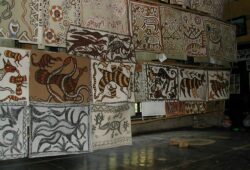The Enchanting World of Marc Chagall’s Paintings
 Posted On
Posted On
Marc Chagall, the renowned Russian-French artist, is celebrated for his unique and captivating paintings that transport viewers to a world of dreamlike enchantment. Born in 1887 in Belarus, Chagall’s artistic journey took him from the rural landscapes of his homeland to the bustling streets of Paris, where he became an influential figure in the world of modern art. Throughout his prolific career, Chagall’s paintings exuded a sense of magic, blending elements of fantasy, folklore, and personal memories. One of his most iconic works, “The Fiddler,” epitomizes his distinctive style and enduring legacy.
The Fiddler: A Window into Chagall’s World
“The Fiddler” is a masterpiece painted in 1912, during Chagall’s time in Paris. The painting depicts a whimsical scene featuring a fiddler, floating houses, and a couple embraced in midair. The rich and vibrant colours, characteristic of Chagall’s work, bring the composition to life, evoking a sense of joy and jubilation. The fiddler himself, playing passionately atop a rooftop, seems to be the central figure in a fantastical dance that defies gravity and convention.
Chagall’s blending of the everyday and the extraordinary is evident in “The Fiddler.” The imagery of the floating houses is reminiscent of his childhood memories of Vitebsk, his hometown, where he witnessed houses seemingly defying gravity. This blending of the ordinary and the otherworldly was a recurring theme in Chagall’s oeuvre, reflecting his deep connection to his cultural roots and Jewish heritage.

Influences and Inspirations
Chagall’s unique artistic style was shaped by several influential factors throughout his life. He was deeply influenced by the Russian folk art and the Jewish traditions of his childhood. These early experiences laid the foundation for his dreamlike depictions of village life, folklore, and religious themes. Additionally, the works of French fauvist painters and the Cubist movement, which were prominent during his time in Paris, left a lasting impact on his artistic expression.
Love, Romance, and Longing
One of the recurring motifs in Chagall’s paintings is the portrayal of love and romance. His works often feature ethereal, levitating couples, like in “The Fiddler,” expressing a sense of boundless affection and longing. These motifs are believed to be inspired by his profound love for his first wife, Bella Rosenfeld, whom he often depicted as a muse in his paintings. The intensity of their relationship is palpable in his works, imbuing them with a sense of emotional depth and tenderness.
Beyond the Canvas
Chagall’s artistic talents extended beyond painting, as he also delved into other forms of artistic expression, such as stained glass, ceramics, and tapestries. His exceptional stained-glass artworks adorn numerous places of worship, including the iconic stained-glass windows at the Hadassah Medical Centre in Jerusalem and the United Nations headquarters in New York City. These monumental installations showcase his ability to infuse spirituality and hope into his art.
Legacy and Influence
Marc Chagall’s impact on the art world was profound and enduring. His imaginative and poetic approach to art inspired countless artists and continues to captivate audiences worldwide. His works remain highly sought after, fetching significant prices at auctions and adorning prestigious museum collections.
Marc Chagall’s paintings, particularly exemplified by “The Fiddler,” are a testament to the power of art in creating enchanting worlds that resonate with viewers on a deeply emotional level. His ability to blend the mystical and the ordinary, combined with his passion for love and folklore, resulted in a visual language uniquely his own. Chagall’s legacy endures as a beacon of artistic brilliance, reminding us of the boundless possibilities of the human imagination and the profound emotions that art can evoke.



